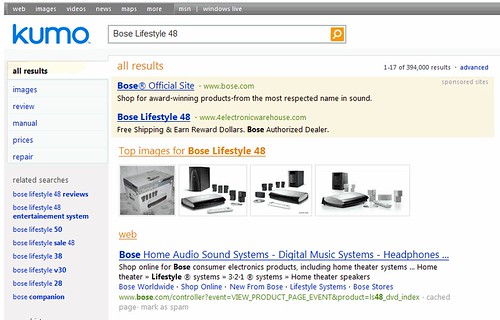Kumo: Microsoft Tests Search Ideas With Its Own Employees
Like many others, I saw the mention that came out on LiveSide earlier today about Microsoft’s new search interface and potential “Kumo” brand change. Now we, along with others, have received an internal memo about the changes along with some further screenshots Before jumping in, let’s talk about the brand change. I’ve lost track of […]
Like many others, I saw the mention that came out on LiveSide earlier today about Microsoft’s new search interface and potential “Kumo” brand change. Now we, along with others, have received an internal memo about the changes along with some further screenshots
Before jumping in, let’s talk about the brand change. I’ve lost track of the number of times now over the past year that Microsoft has said they are considering changing their search brand or definitely will do it. It’s just an open source fact at this point: the brand is going to change. The question is, to what?
Kumo? We heard that back in November. I really doubt that will be the final name, if only for the lukewarm reaction it gained when that rumor first came out. Microsoft also gave me an official statement that downplays Kumo as its successor search brand:
Microsoft is using the Kumo.com URL for internal testing purposes only. Given the depth and breadth of our current online service offering, we recognize a need to sharply define and align our online brands. However, we have nothing new to announce at this time.
That leads to those screenshots. We got them along with a memo that Microsoft’s Satya Nadella sent out all Microsoft employees today:
The Search team needs you. We’ve been working hard to improve our search service and want to share the progress we are making with you. We are launching a new test program called kumo.com for employees to try and provide feedback. Kumo.com exists only inside the corporate network, and in order to get enough feedback we will be redirecting internal live.com traffic over to the test site in the coming days. Kumo is the codename we have chosen for the internal test.
In spite of the progress made by search engines, 40% of queries go unanswered; half of queries are about searchers returning to previous tasks; and 46% of search sessions are longer than 20 minutes. These and many other learnings suggest that customers often don’t find what they need from search today.
We believe we can provide a better and more useful search experience that helps you not just search but accomplish tasks. During the test, features will vary by country, but you’ll see results organized in a way that saves you more time. An explorer pane on the left side of results pages will give you access to tools that help you with your tasks. Other features like single session history and hover preview help accomplish more in search sessions.
Your Next Search…
To get started, visit kumo.com or click one of the samples below to see how it’s possible to find the right results more easily:
You can also set your search defaults to test site using the instructions here.
Your Feedback is Critical
As employees, you are some of our most informed users and our toughest critics, and we highly value your input and feedback to help us build a better service. You have been an important voice in our efforts, and the feedback you’ve sent us since the company meeting has been amazing.
When you visit kumo.com, at the bottom right corner of the each page you’ll see a feedback badge. We ask that each time you use the test site, click the feedback badge and take a moment to answer four quick and simple questions. Feel free to reach out to give us extra feedback directly on our blog and by mailing sfeed. For answers to common questions make sure to see our FAQ.
We are committed to rapid innovation and improvement. Please give the test site a try, rate the results and let us know what you think
I think it’s safe to say that Kumo isn’t going to emerge as the new consumer search brand. It would be a bad way to kick that off, I’d say, using it first internally this way.
How about those changes? You can take a look in the screenshots below. I’ve done some close-ups, plus you can clickthrough to larger versions of the full pages.
Probably most striking is that the internal product uses a somewhat similar “3D view” to what Ask.com tried back in 2007 (see Ask Relaunches: Now “Ask 3D”). It’s more 2D, however. Where Ask had a “refine” pane on the left-hand side of the screen, then results in the middle and vertical search results on the right-hand side, Kumo has only the refine area on the left and results in the middle:
Former Ask.com CEO Jim Lanzone, on the many occasions I’ve talked with him about the design changes tried under his watch, has been steadfast in that they were working. So perhaps if this goes into final production for Microsoft, they’ll see a change, too. Of course, I’m pretty sure we’ve seen Google experiment with a similar use of the left-hand pane for refinement, so it’s not a major innovation or something that couldn’t be replicated, if it takes off.
What about that third pane for vertical results? Well, Ask eventually dumped it to return to carrying ads there. I’ll presume they found they couldn’t take the revenue hit that losing them in that spot might have caused. Certainly Microsoft doesn’t seem convinced to replicate the right-side for vertical search results.
Look more closely at the screenshot, and you’ll see the other striking change. Classification of search results. For this query on Taylor Swift, you can drill in and focus results about her that are just about her songs, lyrics, music, vidoes and so on. How good this focusing in is uncertain, as I can’t actually drill down.
This type of classification or “drill down” into results isn’t new. It’s years old, tried by players such as Clusty, not to mention Google offer types of refinement right now plus Yahoo talked about this type of task-based refinement being in the works.
Here’s another example for Bose, where you can see topics like “repair” and “prices” are shown:
Scroll down a page, and you’ll see that results are also divided into different topic areas, as in this Audi search:
See how you get some results about Audi S8 parts, then later, Used Audi S8 parts?
Again, this type of division of results into topic areas isn’t new. Google actually does it now, and if I have time later, I’ll link over to the exact name for it and a few examples. They tend to do it on only one topic, however — shove in results right to the middle of the page.
Microsoft actually used to do this type of topic division years and years ago, too — back when they had a much more human-based results system.
I don’t mean to downplay the features shown. This is a testing site, and we’re only dealing with screenshots, rather than playing with how the refinement actually works. Perhaps it will be killer. Certainly, Microsoft should be experimenting with both new and old ideas and is in a good position to do so, since unlike Google, it doesn’t run the risk of potentially scaring off users with something they might find weird or scary (since it has so fewer seachers than Google).
But really, I thought far more interesting is the feature Vanessa Fox covered earlier today that’s live on the current site for some people, covered in her Microsoft Live Search Tests: Best Match And Categorized Listings post. Even things like a search engine trying to show a single “best match” isn’t a new idea. Major search engines have tried this in the past. But get that right, especially for non-navigational searches (you know, you search for Amazon, Amazon gets listed first — that’s a easy navigational query to fix), and you might have a compelling feature that attracts more searchers to your service.
Postscript: Microsoft has now publicly blogged about the testing here.
Postscript 2: Some users get Kumo layout in Live Search covers how some people — non-Microsoft employees — are seeing the new design outside Microsoft’s internal network.
Contributing authors are invited to create content for Search Engine Land and are chosen for their expertise and contribution to the search community. Our contributors work under the oversight of the editorial staff and contributions are checked for quality and relevance to our readers. The opinions they express are their own.
Related stories
New on Search Engine Land



